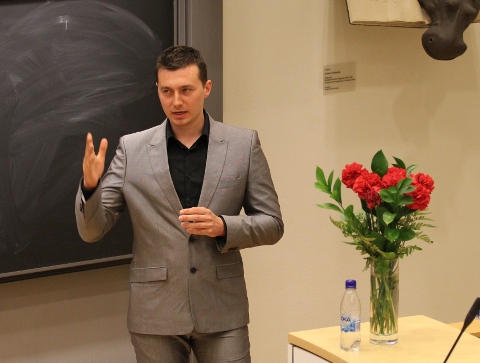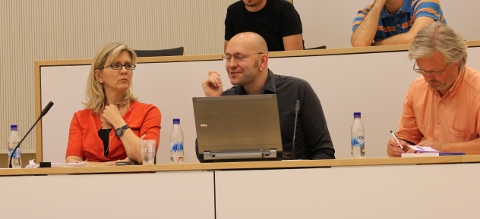Andrzej Pronobis successfully defends his thesis
At 15:17 on June 10 Prof Jana Kosecka, chairman of the grading committee delivered the good news to Andrzej Pronobis.
Candidate Andrzej Pronobis defending

Opponent Prof Jim Little


Grading committee: Jana Kosecka, Achim Lilienthal and Joakim Gustafson

Abstract
After decades of unrealistic predictions and expectations, robots have finally escaped from industrial workplaces and made their way into our homes, offices, museums and other public spaces. These service robots are increasingly present in our environments and many believe that it is in the area of service and domestic robotics that we will see the largest growth within the next few years. In order to realize the dream of robot assistants performing human-like tasks together with humans in a seamless fashion, we need to provide them with the fundamental capability of understanding complex, dynamic and unstructured environments. More importantly, we need to enable them the sharing of our understanding of space to permit natural cooperation. To this end, this thesis addresses the problem of building internal representations of space for artificial mobile agents populated with human spatial semantics as well as means for inferring that semantics from sensory information. More specifically, an extensible approach to place classification is introduced and used for mobile robot localization as well as categorization and extraction of spatial semantic concepts from general place appearance and geometry. The models can be incrementally adapted to the dynamic changes in the environment and employ efficient ways for cue integration, sensor fusion and confidence estimation. In addition, a system and representational approach to semantic mapping is presented. The system incorporates and integrates semantic knowledge from multiple sources such as the geometry and general appearance of places, presence of objects, topology of the environment as well as human input. A conceptual map is designed and used for modeling and reasoning about spatial concepts and their relations to spatial entities and their semantic properties. Finally, the semantic mapping algorithm is built into an integrated robotic system and shown to substantially enhance the performance of the robot on the complex task of active object search. The presented evaluations show the effectiveness of the system and its underlying components and demonstrate applicability to real-world problems in realistic human settings.